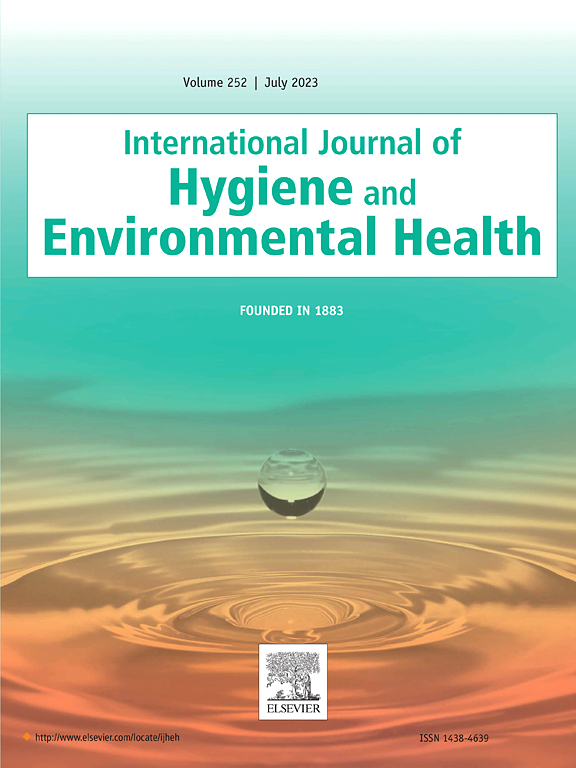First application of enterophages for monitoring faecal pollution in the temperate Baltic region of Northern Poland
IF 4.5
2区 医学
Q1 INFECTIOUS DISEASES
International journal of hygiene and environmental health
Pub Date : 2025-07-01
DOI:10.1016/j.ijheh.2025.114622
引用次数: 0
Abstract
This study investigates the abundance of enterophages, a novel faecal indicator, in raw and treated sewage at two Wastewater Treatment Plants (WWTPs) in Pomerania, Poland, serving a population of 1.2 million inhabitants. Using the ISO-standardized double agar layer (DAL) method, we compared enterophages with other biological indicators, including coliphages, Escherichia coli, and enterococci. We observed that, although enterophages were present, they formed smaller plaques than coliphages, which complicated detection. Despite this, the study identified a strong presence of E. coli in both raw and treated wastewater, with lower concentrations of enterophages, consistent with other global studies. Enterophages were found to be less abundant than bacterial indicators and coliphages, suggesting a potentially more specific human source. The concentration of enterophages in treated sewage decreased significantly, supporting their potential as indicators of untreated sewage contamination in water bodies. Our results also revealed that enterophages counts in raw sewage were higher than those reported in tropical regions, possibly due to differences in methodology and bacterial strains used. Furthermore, correlation analyses indicated that microbial indicators in raw sewage were linked with chemical parameters such as temperature and orthophosphates, which may influence their presence. The study concludes that while enterophages are viable alternative faecal indicators, their low abundance in treated wastewater highlights the need for further research, including survivability studies and the development of molecular detection methods. This research contributes to the understanding of enterophages in temperate climates and underscores the importance of regional collaboration in optimizing faecal contamination monitoring methodologies.
在波兰北部波罗的海温带地区首次应用噬菌体监测粪便污染
本研究调查了波兰波美拉尼亚两个污水处理厂(WWTPs)的未经处理和处理的污水中噬菌体的丰度,这是一种新的粪便指标,为120万居民提供服务。采用iso标准双琼脂层(DAL)法,我们比较了肠噬菌体与其他生物指标,包括噬菌体、大肠杆菌和肠球菌。我们观察到,虽然存在肠噬菌体,但它们形成的斑块比噬菌体小,这使检测变得复杂。尽管如此,该研究发现,在未经处理的废水和处理过的废水中都存在大量大肠杆菌,而噬菌体的浓度较低,这与其他全球研究结果一致。研究发现,肠道噬菌体的数量少于细菌指标和噬菌体,这表明可能存在更具体的人类来源。处理后的污水中噬菌体的浓度显著下降,支持它们作为水体中未经处理的污水污染指标的潜力。我们的研究结果还显示,原始污水中的肠道噬菌体计数高于热带地区的报告,可能是由于方法和使用的细菌菌株的差异。此外,相关分析表明,原污水中的微生物指标与温度和正磷酸盐等化学参数有关,这可能会影响它们的存在。该研究的结论是,虽然肠道噬菌体是可行的替代粪便指标,但它们在处理过的废水中的丰度很低,这突出了进一步研究的必要性,包括生存能力研究和分子检测方法的开发。这项研究有助于了解温带气候下的肠道噬菌体,并强调了区域合作在优化粪便污染监测方法方面的重要性。
本文章由计算机程序翻译,如有差异,请以英文原文为准。
求助全文
约1分钟内获得全文
求助全文
来源期刊
CiteScore
11.50
自引率
5.00%
发文量
151
审稿时长
22 days
期刊介绍:
The International Journal of Hygiene and Environmental Health serves as a multidisciplinary forum for original reports on exposure assessment and the reactions to and consequences of human exposure to the biological, chemical, and physical environment. Research reports, short communications, reviews, scientific comments, technical notes, and editorials will be peer-reviewed before acceptance for publication. Priority will be given to articles on epidemiological aspects of environmental toxicology, health risk assessments, susceptible (sub) populations, sanitation and clean water, human biomonitoring, environmental medicine, and public health aspects of exposure-related outcomes.

 求助内容:
求助内容: 应助结果提醒方式:
应助结果提醒方式:


